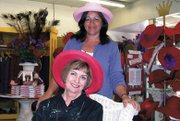Group Strikes Gold With Red Hats
Fashion tends to fixate on youth, but in the past year, companies have been clamoring to license products for The Red Hat Society Inc., a national club for women aged 50 and older.
The fast-growing social club, with an estimated 600,000 women, is raising its profile. Members wear red hats and purple clothes at national conventions and local shindigs. They also support favorite products, such as founder Sue Ellen Cooper’s book “The Red Hat Society: Fun and Friendship After Fifty,” which has charted on The New York Times bestseller list since Warner Books Inc. published it in April. Warner supported the book with fullpage ads in magazines including People.
Cooper said she got into business after she received requests for society mementoes and apparel. She hoped to support the club’s activities, offices and Web site (www.redhatsociety.com) through Red Hat knickknacks. Success would be modest, she thought. She was wrong.
The society works with more than 20 licensees, including the Dorfman-Pacific Co., a Stockton, Calif.–based hat manufacturer, and the Ruby Sport & Ruby Elite Collections by TIA Designs, a misses and plus-size manufacturer based in Pompano Beach, Fla. The club looks forward to building 20 more licensees by the end of 2004, according to Sabrina Contreras, vice president of merchandising and product development.
The society sells licensed clothes and accessories at its 3,000-square-foot Imperiumretail store in Fullerton, Calif., 27 miles southeast of Los Angeles. Contreras plans to expand the Fullerton store and possibly build 12 more shops during the next few years. Price points range from $5 for a lapel pin to $61 for a sweater. Contreras did not divulge the revenue earned by the store or the licensees.
Dorfman-Pacific became the society’s official licensee for hats in March. Doug Highsmith, president and chief executive officer of Dorfman- Pacific, anticipates The Red Hat Society will be a significant source of revenue for his company.
Sales of red hats have increased 300 percent to 500 percent throughout the industry during the past three years, according to Highsmith. His company will introduce 40 styles of red hats for the Fall 2004 season. Styles will include traditional shapes constructed in straw, cloth and felt; Western hats; and tennis visors.
“I went to their Dallas convention in March, and I saw 4,000 women all dressed in red hats and purple clothes,” Highsmith said. “A man in the hat business couldn’t ask for any better.”
Businesses targeting women aged 50 and older should find success because these women make up a wealthy group that is ignored, according to Mary Furlong, president of Mary Furlong & Associates, a business and marketing research group based in Lafayette, Calif.
“They spend 15 percent more than younger groups,” Furlong said of women aged 50 and older, noting that many own businesses or hold executive positions. “As children leave, discretionary income goes up, and they’re going to spend more on fashion and apparel.”
The Red Hat Society started as a lark in 1998, when Cooper gave a friend a 50th birthday gift of a red felt fedora and Jenny Joseph’s poem “Warning,” which depicts a woman growing older with gentle humor and a lust for life—while wearing a red hat.
Cooper’s friends exchanged similar gifts of hats and poems on their 50th birthdays and later decided to organize the silliness. Now, the club has more than 30,000 registered chapters in 22 countries. Most chapters are located in Florida and California.
Cooper claims this success came as a surprise. “If we thought of this beforehand, we’d be geniuses,” she said. “I’d like to say we’re geniuses.” —Andrew Asch






















